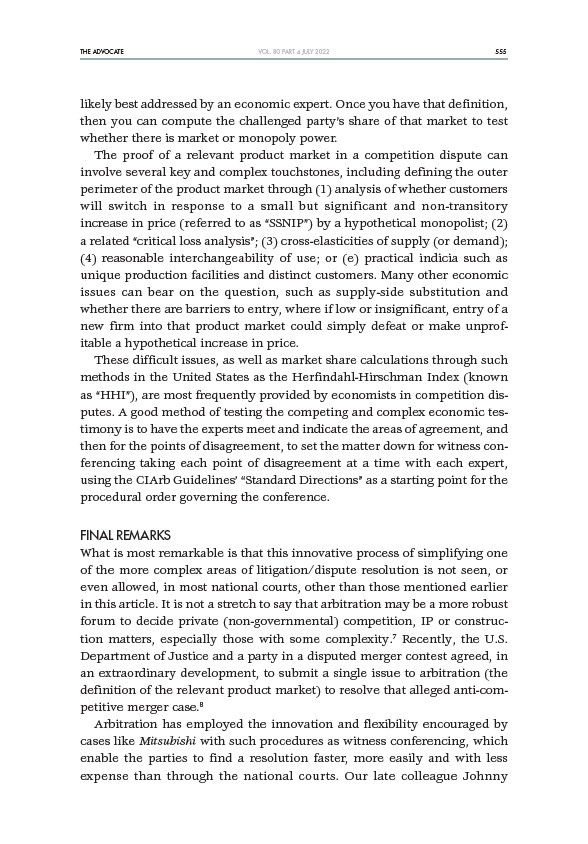
THE ADVOCATE 555
VOL. 80 PART 4 JULY 2022
likely best addressed by an economic expert. Once you have that definition,
then you can compute the challenged party’s share of that market to test
whether there is market or monopoly power.
The proof of a relevant product market in a competition dispute can
involve several key and complex touchstones, including defining the outer
perimeter of the product market through (1) analysis of whether customers
will switch in response to a small but significant and non-transitory
increase in price (referred to as “SSNIP”) by a hypothetical monopolist; (2)
a related “critical loss analysis”; (3) cross-elasticities of supply (or demand);
(4) reasonable interchangeability of use; or (e) practical indicia such as
unique production facilities and distinct customers. Many other economic
issues can bear on the question, such as supply-side substitution and
whether there are barriers to entry, where if low or insignificant, entry of a
new firm into that product market could simply defeat or make unprofitable
a hypothetical increase in price.
These difficult issues, as well as market share calculations through such
methods in the United States as the Herfindahl-Hirschman Index (known
as “HHI”), are most frequently provided by economists in competition disputes.
A good method of testing the competing and complex economic testimony
is to have the experts meet and indicate the areas of agreement, and
then for the points of disagreement, to set the matter down for witness conferencing
taking each point of disagreement at a time with each expert,
using the CIArb Guidelines’ “Standard Directions” as a starting point for the
procedural order governing the conference.
FINAL REMARKS
What is most remarkable is that this innovative process of simplifying one
of the more complex areas of litigation/dispute resolution is not seen, or
even allowed, in most national courts, other than those mentioned earlier
in this article. It is not a stretch to say that arbitration may be a more robust
forum to decide private (non-governmental) competition, IP or construction
matters, especially those with some complexity.7 Recently, the U.S.
Department of Justice and a party in a disputed merger contest agreed, in
an extraordinary development, to submit a single issue to arbitration (the
definition of the relevant product market) to resolve that alleged anti-competitive
merger case.8
Arbitration has employed the innovation and flexibility encouraged by
cases like Mitsubishi with such procedures as witness conferencing, which
enable the parties to find a resolution faster, more easily and with less
expense than through the national courts. Our late colleague Johnny